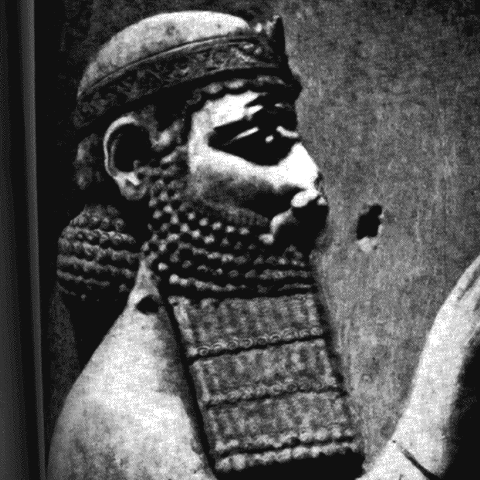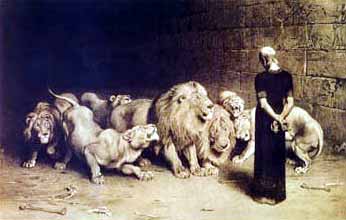
Reprinted from Meridian Magazine (15 Sep 2004)
©2004 by John P. Pratt. All rights Reserved.
| 1. Daniel's Prophecy |
| 1.1 Traditional Interpretations |
| 1.2 Newton's Interpretation |
| 2. Prophecy Fulfilled |
| 2.1 Ezra's Commission |
| 2.2 Crucifixion Date |
| 2.3 Accurate to the Day |
| 2.4 AD 33 Crucifixion |
| 2.5 Daniel Vindicated |
| 3. Conclusion |
| Notes |
Are there any prophecies in the Old Testament of when the Messiah would be born? There are several prophecies about Jesus Christ in Isaiah and Psalms, which describe many of the things that the Messiah would do when he would come to earth. But was any hint provided of exactly when the mission of Jesus Christ's first coming would be fulfilled?
Yes, there is one very precise prophecy found in the book of Daniel. It has been understood for centuries to have been accurate to within a few years, or even to the very year, but there has been no general agreement on how the details were fulfilled.
The purpose of this article is to show for the first time that Daniel's prophecy is accurate to the very day on the Enoch calendar. Thus, the prophecy stands as a witness of both the foreknowledge of God and also of the precise timing of events of the Savior's life, planned from the foundation of the world. It also is a testimony of the authenticity of the Book of Daniel.
 |
Because this prophecy is the centerpiece of this article, let us consider it in detail:
Seventy weeks are determined upon thy people and upon thy holy city, to finish the transgression, and to make an end of sins, and to make reconciliation for iniquity, and to bring in everlasting righteousness, and to seal up the vision and prophecy, and to anoint the most Holy.
Know therefore and understand, that from the going forth of the commandment to restore and to build Jerusalem unto the Messiah the Prince shall be seven weeks, and threescore and two weeks: the street shall be built again, and the wall, even in troublous times.
And after threescore and two weeks shall Messiah be cut off, but not for himself: and the people of the prince that shall come shall destroy the city and the sanctuary; and the end thereof shall be with a flood, and unto the end of the war desolations are determined.
And he shall confirm the covenant with many for one week: and in the midst of the week he shall cause the sacrifice and the oblation to cease, and for the overspreading of abominations he shall make it desolate, even until the consummation, and that determined shall be poured upon the desolate. (Daniel 9:24-27)
Most Bible commentators agree that the "most Holy" and "Messiah" in this prophecy refer to Jesus Christ, and that "cut off" refers to his death at the Crucifixion. They also agree that "weeks" refers to weeks of years, such as the Lord commanded Israel to reckon (Lev. 25). But that is about the end of the agreement. If the reader does an internet search for "seventy weeks prophecy" the result is at least fifty articles, with almost as many interpretations. Most of them have seemed contrived to me, trying to force the numbers to come out right, like Cinderella's step-sisters trying to cram their foot into her glass slipper. The traditional interpretations appear to be a mass of confusion, allowing one to start from any of several starting points, count either 69, 69.5 or 70 weeks of years of various lengths, to end on any of several dates, including proposed dates for the Savior's baptism and triumphal entry. With one notable exception,[2] most interpretations claim that the prophecy is accurate to the year, but they all have to change one or both of the end years to make it work.
Because of my work in biblical chronology, it has been necessary for me also to attempt to understand this marvelous prophecy. After reading many of the proposed interpretations decades ago, I ended up convinced that all of those interpretations were wrong, but unable to offer anything better. Hence, there has been no mention of Daniel's prophecy anywhere in my work until now. Then, as last month's article about Sir Isaac Newton was being written,[3] it became clear that he had provided the key to finally understand at least part of Daniel's prophecy.
 |
Thus, Newton focused only on the two end points of the seventy weeks. To him it was clear that the prophecy meant that it would be seventy weeks of years from the beginning of the rebuilding of Jerusalem until the crucifixion of Jesus Christ.
The book of Ezra gives the year of the decree to rebuild Jerusalem as being the seventh year of Artaxerxes (Ezra 7:7). While that might not mean much to the average modern reader, Newton's extensive knowledge of ancient history allowed him to identify that Persian king as Artaxerxes I (Artaxerxes Longimanus), and to place the decree in the year 458 BC.
Newton then calculated the Crucifixion date as being either in AD 33 or 34. The way he did it was remarkable. He used his own new theory of gravity to calculate the position of the moon in antiquity to reconstruct the Judean calendar to find a year in which the day of the preparation for Passover fell on a Friday. He was so far ahead of his time that his work was almost entirely overlooked, and that same method was "rediscovered" two centuries later, with essentially the same results.[4]
Newton then pointed out that Daniel's prophecy of seventy weeks, or 490 years, would fit perfectly either between the year of Ezra's commission in 458 BC and AD 33, which he acknowledged as the commonly accepted year for the Crucifixion, or it could also fit between the years 457 BC when Ezra actually got started working and AD 34.[5]
Newton favored the latter choice for two reasons. First it makes Daniel's prophecy come out even not only in weeks of years, but both ends would also fall in the sacred seventh sabbatical year of the cycle. That is, both the years 457 BC and AD 34 were Jewish sabbatical years, which seemed like a very tidy fit to Newton because the entire prophecy was about weeks of years. Secondly, Newton favored AD 34 because he thought he found evidence for the Savior's ministry having been 4.5 years, rather than the traditional 3.5 years. This evidence has not been accepted by modern scholars, who do not consider AD 34 as a plausible year for the Crucifixion.
Newton provided the key to understanding the prophecy when he explicitly stated that for those who prefer AD 33 as the year of the Crucifixion, they could count exactly seventy weeks from the year that Ezra began his journey. Because of new facts found since the time of Newton, to me the evidence is overwhelming that the crucifixion of Jesus Christ occurred on Fri, 1 Apr AD 33 on our Gregorian calendar, as published nearly two decades ago.[6] Last month, while writing the article reviewing Newton's interpretation of Daniel's prophecies, it occurred to me to follow up on Newton's suggestion, which he had left as an "exercise for the student," to see just how accurate Daniel's prophecy might really have been, based on the AD 33 crucifixion date.
Let us now determine the exact beginning point of the prophecy.
 |
The standard reference for dates of that period on the Babylonian calendar is a set of tables produced by Parker and Dubberstein, which give the exact day for the first day of every month. The day listed in their tables, which is guaranteed not to have been influenced by any desire to force the prophecy to come out neatly, is Sat 3 Apr 458 BC.[7] Thus, modern scholarship agrees perfectly with Newton on the year. Even though common interpretations of the prophecy also begin from Ezra's commission to rebuild Jerusalem, the date usually listed is 456 or 457 BC. There is rarely a reference justifying those years. They appear to have been chosen simply to accommodate one particular interpretation of the seventy weeks prophecy. Any departure from the Parker and Dubberstein value should require some sort of explanation.
There are only two viable dates accepted by scholars for the crucifixion of Jesus Christ. The more popular is Fri 5 Apr AD 30 (on our modern Gregorian calendar), but several scholars prefer the other choice of Fri 1 Apr AD 33.[8] The best summary of modern scholarship is Jack Finegan's Handbook of Biblical Chronology, and these are the two dates which he lists as possible. Recent evidence has now persuaded him to favor the AD 33 date.[9]
Briefly, the AD 30 date best fits all of the evidence concerning both the birth and death of Christ, including secular sources, whereas the AD 33 date is the one that best fits the New Testament account of the Crucifixion. For nearly two decades my work has emphasized that it is the AD 33 date which must be correct, and that the secular source of Josephus is wrong about the date of Herod's death. The only reason to prefer the AD 30 date is to accommodate the death of Herod having been in 4 or 3 BC as Josephus states (and hence Christ's birth about 6-5 BC). Now evidence indicates that Herod died about February of AD 1.[10]. Thus, there is no longer a compelling reason to abandon the biblical Crucifixion date of Fri 1 Apr AD 33.
 |
Those familiar with my work will know that in virtually every case, the Lord's prophecies are fulfilled not only to the year, but to the very day. Can that be the case with the seventy weeks prophecy?
On our modern Gregorian calendar, the two dates are very close to exactly 490 years apart. After all, the interval begins on April 3 and ends on April 1. But we have no reason to suspect that the Lord has ever employed our Roman calendar, which is a corrected form of that proposed by Julius Caesar. What is the interval on calendars which the Lord has authorized, such as the Hebrew Calendar and the Enoch Calendar?
On the Hebrew Calendar, the day of Ezra's departure was the first day of the first month (1 Nisan),[11] and the crucifixion of Christ was on the day on which the Passover lamb was sacrificed (14 Nisan). So the interval is nearly two weeks more than 490 years on the Hebrew calendar.
What about the Enoch Calendar? The solar calendar of Enoch is much more like our Gregorian calendar, except that it is based on weeks so that it begins every year on a Sunday, and adds an entire week of days when needed to keep the first day of the year near the spring equinox (21 Mar). Because this calendar is based on weeks (of days), it seems especially appropriate for consideration as a candidate to have been used in a prophecy concerning weeks (of years). As has been explained in previous articles, the first day of the Enoch year tends to be the Sunday on or after the spring equinox.[12] In the year 458 BC the first day of the first month of the Enoch year fell on Sun 21 Mar, on the very day of the spring equinox. That means that the day of Ezra's departure, Sat 3 Apr 458 BC, was the 14th day of the first month (14 Spring), which is Passover on that calendar.
As has been published previously, the day of the Crucifixion, Fri 1 Apr AD 33, was the day preceding Passover on the Enoch calendar.[13] Passover always falls on a Saturday on the Enoch calendar. The Friday Crucifixion completed exactly 490 years to the very day on the Enoch calendar, because the 491st year would have begun on Passover, 2 Apr AD 33.[14]
Thus, the interval from Ezra's departure to rebuild Jerusalem to the date on which the Savior was cut off from life was exactly seventy weeks of years to the very day on the Enoch calendar.
The seventy weeks prophecy also becomes a strong witness of the date of the Crucifixion. There has been a controversy for years over whether the Savior died in AD 30 or AD 33, but there is no real controversy over when the seventh year of Artaxerxes occurred. The best modern dates for Artaxerxes match Newton's to the very year. The fact that the very day listed in the standard tables for the date of Ezra's departure exactly fits with the very day in AD 33, is compelling evidence that the AD 33 Crucifixion date is correct. Thus, Daniel's prophecy not only witnesses of the foreknowledge of God, it also helps resolve a long controversy about the exact date of the Crucifixion.
 |
Sir Isaac Newton provided the key to understanding the seventy weeks prophecy of Daniel. When one reckons from the day that Ezra left to rebuild Jerusalem (Sat 3 Apr 458 BC), to one of the two possible dates for the Crucifixion (Fri 1 Apr AD 33), the interval is almost exactly seventy weeks of years (490 years) on our calendar. When the Enoch calendar is used, then the separation of the two dates completes exactly seventy weeks of Enoch years, to the very day. This precise timing provides a strong witness 1) of God's foreknowledge of both dates, 2) of the authenticity of the Book of Daniel, and 3) of Fri 1 Apr AD 33 as the date of the Crucifixion of Jesus Christ. Truly the Lord has provided several witnesses of the key dates in the Savior's life.